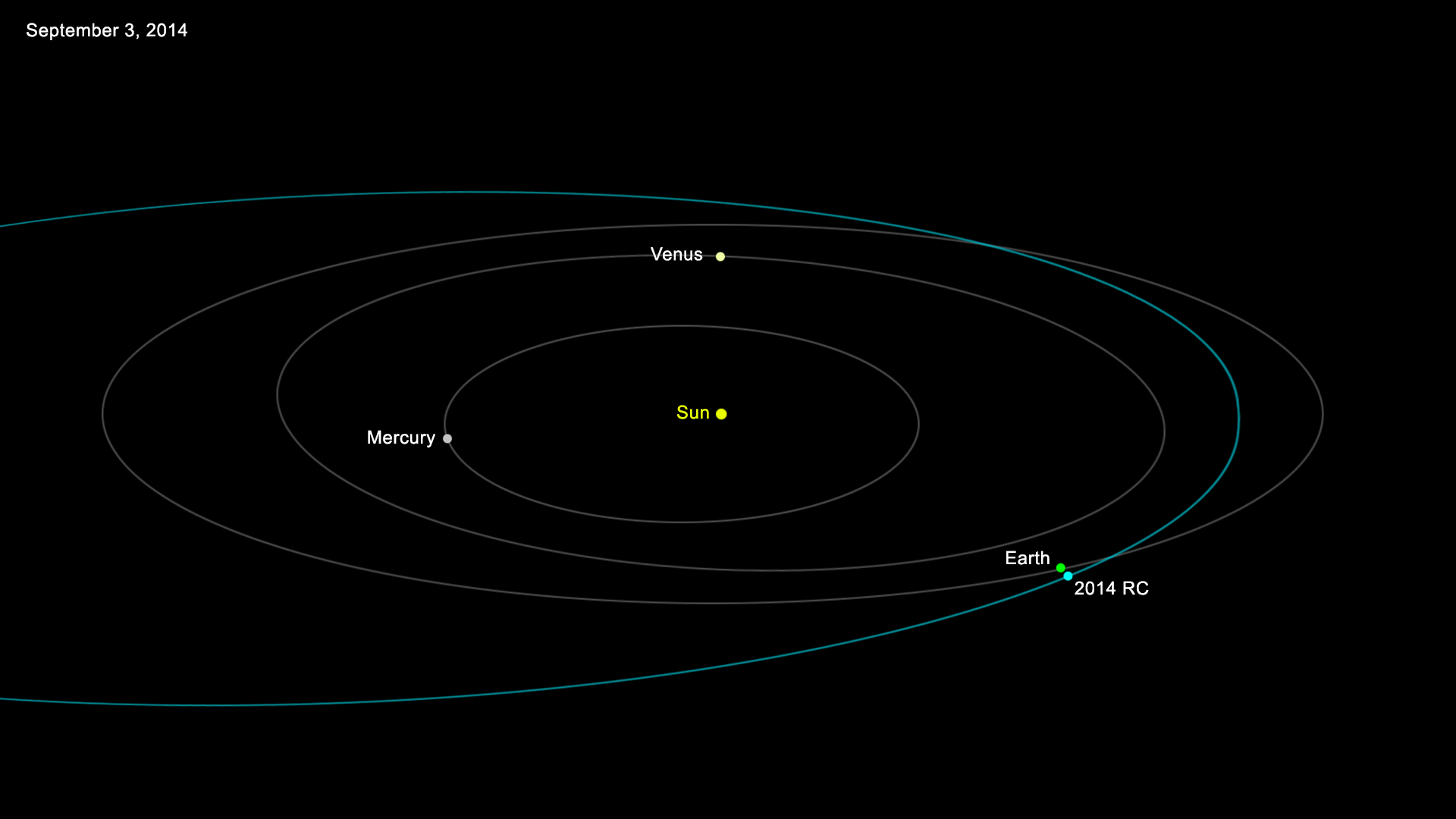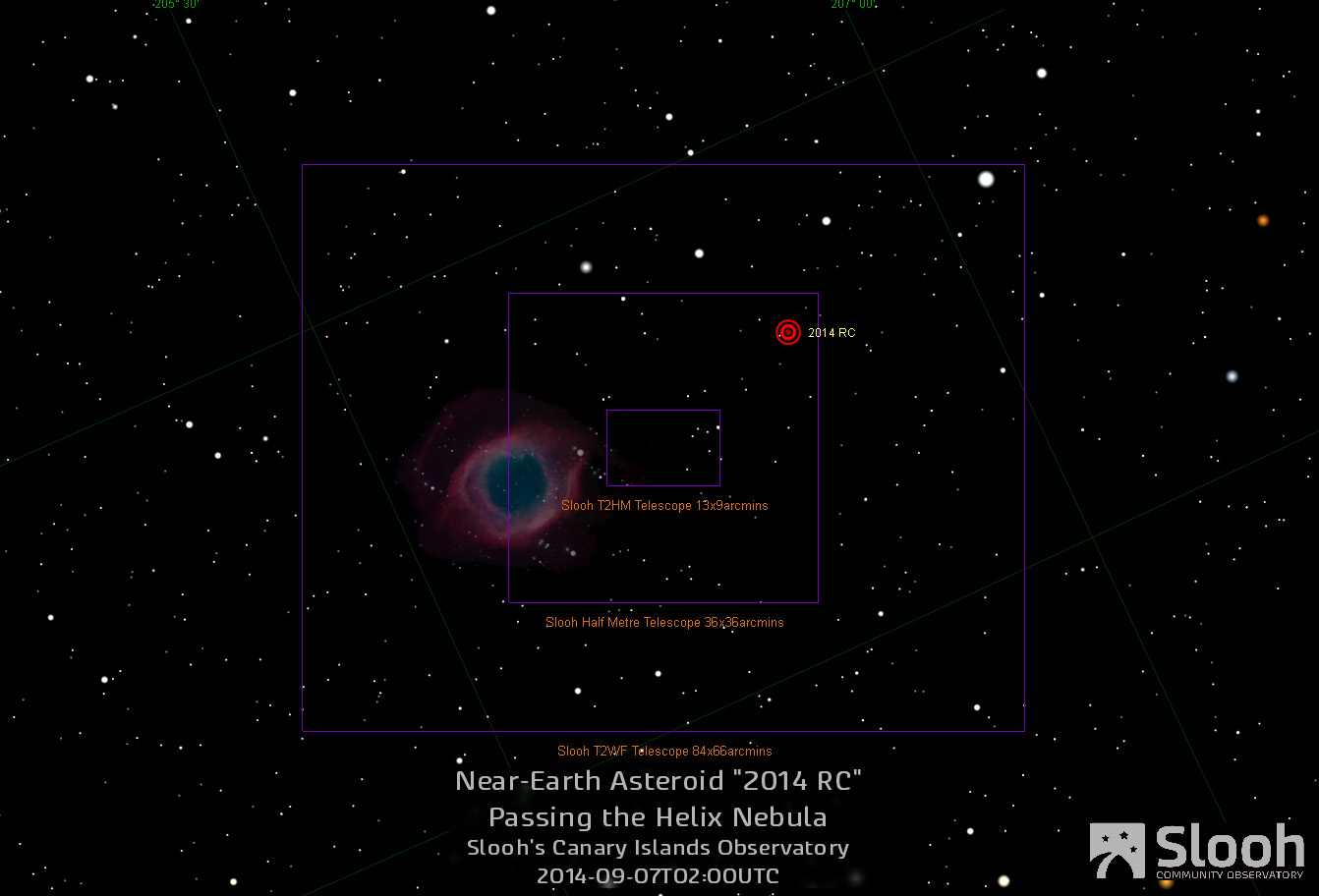Asteroid 2014 RC Is Buzzing Earth This Weekend: See It Online Tonight

A newly discovered asteroid the size of a house is zooming safely by Earth this weekend, and you can see live views of the space rock tonight (Sept. 6) during a series of stargazing webcasts.
Tonight, the online Slooh Community Observatory will set its sights on the near-Earth asteroid 2014 RC — which Slooh nicknamed "Pitbull" — in a one-hour webcast featuring live views of the asteroid, as well as the famed Helix nebula. The 60-foot-wide (20 meters) asteroid poses no threat of hitting Earth when it makes its closest approach on Sunday (Sept. 7), NASA officials have said.
Slooh's webcast will be streamed live at http://www.slooh.com at 10 p.m. EDT (7 p.m. PDT/0200 GMT), and include telescope views from the group's flagship observatory at the Institute of Astrophysics of the Canary Islands, off the west coast of Africa. The Helix nebula will be in the same field of view as the asteroid during the webcast, Slooh representatives said.
You can also watch the asteroid 2014 RC webcast on Space.com, courtesy of Slooh. Asteroid 2014 RC should appear as a bright fast-moving point of light in the telescope webcast. As with all stargazing events, tonight's webcast is dependent on clear weather.
By coincidence, tonight is also International Observe the Moon Night, with many events planned by amateur astronomers around the world. To celebrate the moon-observing night, the Virtual Telescope Project led by astrophysicist Gianluca in Italy will host a moon webcast tonight at 4 p.m. EDT (2000 GMT) and follow it up with an asteroid 2014 RC webcast at 6 p.m. EDT (2200 GMT).
Asteroid 2014 RC was discovered on Aug. 31 by astronomers with the Catalina Sky Survey in Tucson, Arizona. It will come within 21,126 miles (34,000 kilometers) of the Earth's surface during the Sunday flyby. The asteroid will be about one-tenth the distance between the center of the Earth and the moon when it zips by, NASA officials said.
"With a small number of observations made of 2014 RC, there is still uncertainty in its precise orbit," Slooh producer Paul Cox said in a statement. "Slooh members will be tracking the asteroid as it approaches Earth, and will submit their observations to the Minor Planet Center to enable them to better define its orbit."
Get the Space.com Newsletter
Breaking space news, the latest updates on rocket launches, skywatching events and more!
Slooh's asteroid 2014 RC webcast will feature commentary by astronomer Bob Berman and host Geoff Fox. The online observatory nicknamed the asteroid "Pitbull" because of its small size and "scary demeanor," Slooh representatives wrote in a statement.
According to Slooh's Berman: "Pitbull will be too small to appear to the unaided eye. Although amateur telescopes could theoretically see it, its rapid motion will make locating this asteroid a major challenge for all but a small coterie of dedicated, serious astronomers with good star charts."

While asteroid 2014 RC is giving Earth a close shave this weekend, it is by no means the closest asteroid flyby of Earth.
On Feb. 15, 2013, the asteroid 2012 DA14 came within 17,200 miles (27,680 km) of Earth's surface before it safely went on its way. That same day, an asteroid exploded over the Russian city Chelyabinsk, injuring 1,500 people and causing widespread damage to buildings.
The Russian meteor explosion, caused by an asteroid only slightly larger than asteroid 2014 RC, served as a wakeup call to the public to the threat of asteroid impacts on Earth. NASA scientists and astronomers around the world regularly monitor the sky for potentially dangerous asteroids.
Editor's note: If you are a seasoned asteroid tracker and capture an image of video of asteroid 2014 RC and want to share images with Space.com for a gallery or story, send images and comments to managing editor Tariq Malik at: spacephotos@space.com.
For more information on International Observe the Moon Night, and to find an event near you, visit: http://observethemoonnight.org/.
Email Tariq Malik at tmalik@space.com or follow him @tariqjmalik and Google+. Follow us @Spacedotcom, Facebook and Google+. Original article on Space.com.
Join our Space Forums to keep talking space on the latest missions, night sky and more! And if you have a news tip, correction or comment, let us know at: community@space.com.

Tariq is the Editor-in-Chief of Space.com and joined the team in 2001, first as an intern and staff writer, and later as an editor. He covers human spaceflight, exploration and space science, as well as skywatching and entertainment. He became Space.com's Managing Editor in 2009 and Editor-in-Chief in 2019. Before joining Space.com, Tariq was a staff reporter for The Los Angeles Times covering education and city beats in La Habra, Fullerton and Huntington Beach. In October 2022, Tariq received the Harry Kolcum Award for excellence in space reporting from the National Space Club Florida Committee. He is also an Eagle Scout (yes, he has the Space Exploration merit badge) and went to Space Camp four times as a kid and a fifth time as an adult. He has journalism degrees from the University of Southern California and New York University. You can find Tariq at Space.com and as the co-host to the This Week In Space podcast with space historian Rod Pyle on the TWiT network. To see his latest project, you can follow Tariq on Twitter @tariqjmalik.









